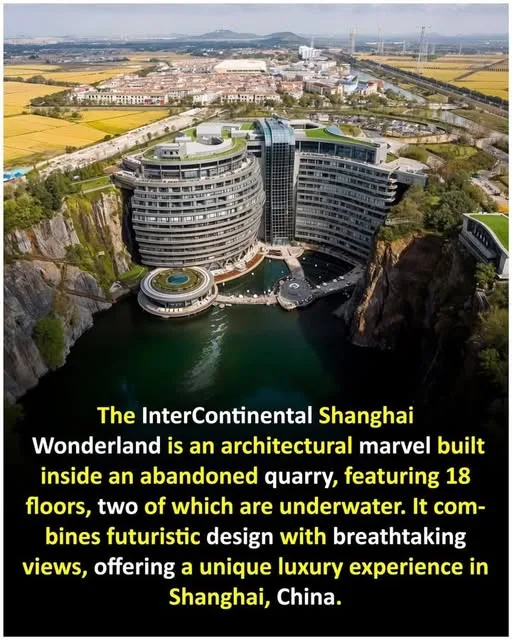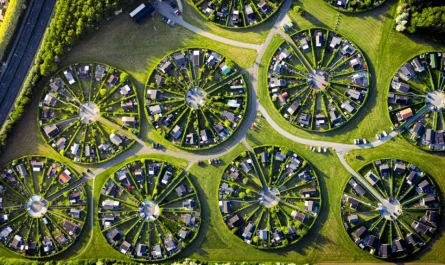InterContinental Shanghai Wonderland: A Futuristic Oasis in an Abandoned Quarry
Nestled in the Songjiang District of Shanghai, China, the InterContinental Shanghai Wonderland stands as a groundbreaking architectural marvel, reimagining an abandoned quarry into a luxurious, futuristic hotel. Opened on November 20, 2018, after a decade of meticulous planning and construction, this hotel rises 18 floors, with two of those floors submerged underwater, offering an unparalleled blend of innovation, sustainability, and breathtaking scenery. Designed by British firm Atkins in collaboration with Shanghai Shimao Property Group, the hotel transforms the 88-meter-deep Songjiang Quarry—abandoned since the 1990s—into a destination that harmonizes natural beauty with cutting-edge design. As of July 2025, it continues to captivate travelers and architects alike, earning accolades for its unique luxury experience and environmental integration.

Architectural Design and Construction
The InterContinental Shanghai Wonderland is a circular structure ingeniously carved into the quarry’s steep, verdant cliffs, with a diameter of approximately 120 meters at its base. Its 18 floors span a vertical range from 16 meters below ground to 2 meters above, creating a dramatic silhouette against the quarry’s rugged landscape. Key design elements include:
- Submerged Floors: The bottom two floors, located 10 meters below the quarry’s artificial lake, house an underwater restaurant, guest rooms, and an aquatic observation lounge. These rooms feature floor-to-ceiling glass windows, offering guests a mesmerizing view of marine life and the lake’s depths, illuminated by natural light filtered through the water.
- Central Atrium: A soaring central atrium, open to the sky, connects the floors with glass elevators and spiral staircases, providing panoramic views of the quarry walls and the hotel’s lush rooftop gardens. The atrium’s design enhances natural ventilation and light, reducing energy consumption.
- Exterior and Materials: The facade combines concrete, glass, and steel, with green roofs on upper levels supporting native plants that blend with the quarry’s ecosystem. The building’s curves mimic the natural contours of the cliffs, minimizing environmental disruption during construction.
- Construction Challenges: Engineers faced significant hurdles, including stabilizing the quarry’s unstable walls, managing groundwater, and ensuring structural integrity underwater. The project required over 3,000 workers, advanced drilling techniques, and a $555 million investment, with construction beginning in 2008 and overcoming delays due to technical and financial issues.
The hotel’s design draws inspiration from nature, aiming to restore the quarry’s ecological balance while showcasing sustainable architecture. It incorporates solar panels, rainwater harvesting, and a heat exchange system using the lake’s temperature, earning it a LEED Gold certification.
Amenities and Guest Experience
The InterContinental Shanghai Wonderland offers 336 rooms and suites, each designed with modern luxury and quarry views in mind. Highlights include:
- Underwater Suites: These rooms, on the B1 and B2 levels, provide a surreal experience with 360-degree views of the lake, where guests can watch fish swim by. Prices range from $400 to $1,200 per night, depending on season and availability.
- Dining Options: The underwater restaurant, “Lago,” serves gourmet cuisine with ingredients sourced locally, while the rooftop “Sky Bar” offers cocktails with vistas of Shanghai’s skyline and the quarry’s greenery. Other dining options include a Cantonese restaurant and a buffet with international fare.
- Recreational Facilities: The hotel features a 20-meter indoor pool, a spa with treatments inspired by traditional Chinese medicine, a fitness center, and a climbing wall integrated into the quarry’s natural rock face. Outdoor activities include guided quarry tours and zip-lining, weather permitting.
- Event Spaces: A grand ballroom and conference rooms cater to corporate events, with capacities up to 500 guests, enhanced by state-of-the-art audiovisual systems.
The hotel’s location, 50 kilometers from central Shanghai, makes it a unique retreat, accessible via a 45-minute drive or shuttle service. Its integration with the quarry’s artificial lake—stocked with koi and other fish—creates a serene ambiance, contrasting with the urban energy of Shanghai.
Cultural and Environmental Significance
The transformation of the Songjiang Quarry into a luxury hotel reflects a growing trend of adaptive reuse in urban development, turning industrial scars into ecological and cultural assets. The quarry, once a source of limestone and construction materials, had become an eyesore and ecological hazard by the 1990s. The project revitalized the area, creating jobs and boosting tourism in Songjiang, a district known for its historical canals and temples.
Environmentally, the hotel mitigates its footprint by preserving 90% of the quarry’s original landscape, using recycled materials, and supporting local biodiversity. The rooftop gardens attract birds and insects, while the lake’s ecosystem is monitored to prevent invasive species. This aligns with Shanghai’s push for sustainable tourism, positioning the hotel as a model for eco-luxury.
Visitor Experience and Challenges
As of July 2025, the InterContinental Shanghai Wonderland is a top destination for luxury travelers and architecture enthusiasts. Guests praise the underwater rooms’ “otherworldly” views and the hotel’s seamless blend of nature and modernity, as seen in posts on X, where users call it “a sci-fi dream” and “Shanghai’s hidden gem.” The hotel hosts seasonal events, like the “Quarry Light Festival” in October, featuring illuminated displays along the cliffs.
Challenges include maintaining the underwater infrastructure, where corrosion and pressure pose risks, and managing visitor numbers to protect the quarry’s ecosystem. The hotel limits occupancy to 700 guests daily, with strict guidelines for waste disposal and noise control. Construction delays and initial safety concerns delayed its opening from 2015 to 2018, but ongoing maintenance ensures its stability.
Future Prospects
Future plans include expanding the quarry trail network for eco-tourism, adding solar-powered electric shuttles, and developing a virtual reality experience to showcase the quarry’s history and construction process. Research into the lake’s aquatic life may enhance conservation efforts, while partnerships with local universities could deepen understanding of the site’s geological past.
Conclusion
The InterContinental Shanghai Wonderland is a triumph of architectural innovation, transforming an abandoned quarry into a luxurious, sustainable retreat. With its 18 floors, including two underwater, it offers breathtaking views, cutting-edge design, and a unique luxury experience in Shanghai. From its challenging construction to its ecological restoration, the hotel embodies human creativity and environmental stewardship. As a beacon of modern tourism, it invites guests to explore a futuristic oasis carved into the earth’s ancient scars, promising to inspire for years to come.





